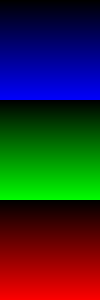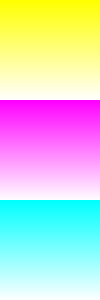What's a Bitmap image?
I'm not going to explain the differences between raster and vector images, nor the difference between bitmap image with extension .bmp and jpg/png images. Herein, the bitmap refers to raster images with .bmp extension only.
Bitmap is uncompressed, and the image is represented with arrays, namely, RGB arrays.
What's the storage of a bitmap
File structure of a bitmap
- The bitmaps stored on the physical devices contains serval parts:
- BITMAPINFO
1. BITMAPINFOHEADER
2. RGBQUAD
2. The stored data in array
-
A bitmap file is composed with
- BITMAPFILEHEADER
- BITMAPINFOHEADER
- Data array
The definition are
typedef struct tagBITMAPFILEHEADER {
WORD bfType; // 2 bytes
DWORD bfSize; // 4 bytes
WORD bfReserved1; // 2 bytes
WORD bfReserved2; // 2 bytes
DWORD bfOffBits; // 4 bytes
} BITMAPFILEHEADER, *LPBITMAPFILEHEADER, *PBITMAPFILEHEADER;
typedef struct tagBITMAPINFO {
BITMAPINFOHEADER bmiHeader;
RGBQUAD bmiColors[1]; // the '1' here is pretty tricky
} BITMAPINFO, *LPBITMAPINFO, *PBITMAPINFO;
typedef struct tagBITMAPINFOHEADER {
DWORD biSize; // 8 bytes
LONG biWidth; // 4 bytes
LONG biHeight; // 4 bytes
WORD biPlanes; //
WORD biBitCount;
DWORD biCompression;
DWORD biSizeImage;
LONG biXPelsPerMeter;
LONG biYPelsPerMeter;
DWORD biClrUsed;
DWORD biClrImportant;
} BITMAPINFOHEADER, *PBITMAPINFOHEADER;
typedef struct tagRGBQUAD {
BYTE rgbBlue;
BYTE rgbGreen;
BYTE rgbRed;
BYTE rgbReserved;
} RGBQUAD;
Let's use Lena.bmp as an illustration:

(Well, this blog doesn;t support BMP image, please see the attach file)
Open it with a hex editor, such as WinHex, and it shows

The highlighted 14 bytes are BITMAPFILEHEADER,
WORD bfType -> 0x4D42
DWORD bfSize -> 0x00010438 = 66616
WORD bfReserved1 -> 0x0000 = 0
WORD bfReserved2 -> 0x0000 = 0
DWORD bfOffBits -> 0x00000436 = 1078
bfTypeshows that this file is a bitmap file;bfSizeis the file size, as we can see below, the file sis 66,614 bytes;bfReserved1andbfReserved2must be zerosbfOffBitsis the offset, in bytes, from the beginning of the BITMAPFILEHEADER structure to the bitmap bits.
e: empcodeMFC_PICTURE_TESTLook into Bitmap images.assets1566902617332.png
And this is the start of array data,

seen what I mean?
The next is BITMAPINFOHEADER, and the data are highlighted in different colors,

and these values can be calculated as
DWORD biSize = 0x00000028 = 40
LONG biWidth = 0x00000100 = 256
LONG biHeight = 0x00000100 = 256
WORD biPlanes = 0x0001 = 1
WORD biBitCount = 0x0008 = 8
DWORD biCompression = 0x00000000 = 0
DWORD biSizeImage = 0x00010002 = 65,538
LONG biXPelsPerMeter = 0x00000B12 = 2,834
LONG biYPelsPerMeter = 0x00000B12 = 2,834
DWORD biClrUsed = 0x000000 = 0
DWORD biClrImportant = 0x000000 = 0
And we can see,
0x0436 + 0x00010002 = 0x00010438
1,078 + 65,538 = 66,616
i.e.
data_start_offset + data_length = file_end
It's the start of data, however, since Lena.bmp is a gray image, all the three channels are same, you can find a pure red/blue image, you will find that, the bitmap is stored in [B, G, R, reserved] order, therefore, if you want to interpret in RGB mode, you should be careful with it.

[C++]Read Bitmap File
The following code are mainly from this website, slightly modified.
typedef unsigned int Uint8;
Uint8* datBuff[2] = { nullptr, nullptr }; // Header buffers
Uint8* pixels = nullptr; // Pixels
BITMAPFILEHEADER* bmpHeader = nullptr; // Header
BITMAPINFOHEADER* bmpInfo = nullptr; // Info
// The file... We open it with it's constructor
std::ifstream file(_T("Lena.bmp"), std::ios::binary);
if (!file){
std::cout << "Failure to open bitmap file.
";
return 1;
}
// Allocate byte memory that will hold the two headers
datBuff[0] = new Uint8[sizeof(BITMAPFILEHEADER)];
datBuff[1] = new Uint8[sizeof(BITMAPINFOHEADER)];
file.read((char*)datBuff[0], sizeof(BITMAPFILEHEADER));
file.read((char*)datBuff[1], sizeof(BITMAPINFOHEADER));
// Construct the values from the buffers
bmpHeader = (BITMAPFILEHEADER*)datBuff[0];
bmpInfo = (BITMAPINFOHEADER*)datBuff[1];
// Check if the file is an actual BMP file
if (bmpHeader->bfType != 0x4D42){
std::cout << "File isn't a bitmap file
";
return 2;
}
// First allocate pixel memory
pixels = new Uint8[bmpInfo->biSizeImage];
// Go to where image data starts, then read in image data
file.seekg(bmpHeader->bfOffBits);
file.read((char*)pixels, bmpInfo->biSizeImage);
// First allocate pixel memory
pixels = new Uint8[bmpInfo->biSizeImage];
// Go to where image data starts, then read in image data
file.seekg(bmpHeader->bfOffBits);
file.read((char*)pixels, bmpInfo->biSizeImage);
// Set width and height to the values loaded from the file
int w = bmpInfo->biWidth;
int h = bmpInfo->biHeight;
// We're almost done. We have our image loaded, however it's not in the right format.
// .bmp files store image data in the BGR format, and we have to convert it to RGB.
// Since we have the value in bytes, this shouldn't be to hard to accomplish
Uint8 tmpRGB = 0; // Swap buffer
for (unsigned long i = 0; i < bmpInfo->biSizeImage; i += 3){
tmpRGB = pixels[i];
pixels[i] = pixels[i + 2];
pixels[i + 2] = tmpRGB;
}
delete[] datBuff[0];
delete[] datBuff[1];
delete[] pixels;
Create Bitmap Image in memory, and draw on screen
The code is mainly from this webpage, slightly modified.
Again, the reference are given:
void CChildView::OnPaint()
{
CPaintDC dc(this); // device context for painting
HDC hdc = dc.m_hDC;
int nWidth = 100;
int nHeight = 100;
int nChannels = 3;
int nImages = 3; // three images in a row, presented in a column
auto nSize = nWidth * nHeight * nChannels * nImages;
unsigned char* data = new unsigned char[nSize] {0};
//memset(data, 0xFF, nSize);
long split = nWidth * nHeight / 4,
nPixel = nWidth * nHeight; // Pixels in an image
// Fill the different images for differnt channels
unsigned char* dat = data;
for (int i = 0; i < nPixel; ++i, dat += 3) // Image 0
dat[0] = (i / nWidth) * (255.0 / nHeight);
for (int i = 0; i < nPixel; ++i, dat += 3) // Image 1
dat[1] = (i / nWidth) * (255.0 / nHeight);
for (int i = 0; i < nPixel; ++i, dat += 3) // Image 2
dat[2] = (i / nWidth) * (255.0 / nHeight);
// Allocate enough memory for the BITMAPINFOHEADER and 256 RGBQUAD palette entries
// NOTE: the pallet bytes are ONLY NEEDED for color LUT images ...
// not needed here
int nColors = 0; // In BI_RGB image, the look-up-table isn't used, so the size can be zero
LPBITMAPINFO lpbi = (LPBITMAPINFO) new BYTE[sizeof(BITMAPINFOHEADER)+ (nColors * sizeof(RGBQUAD))];
// These are all the members of the bitmap header struct
lpbi->bmiHeader.biSize = sizeof(BITMAPINFOHEADER); // bytes
lpbi->bmiHeader.biWidth = nWidth; // pixels units
lpbi->bmiHeader.biHeight = -nHeight * 3; // negative = = top down; pos =
// origin LLeft
lpbi->bmiHeader.biPlanes = 1; // must be 1
lpbi->bmiHeader.biBitCount = 24; // can be 32 for 4-byte pixels
// (Upper byte ignored)
lpbi->bmiHeader.biCompression = BI_RGB; // BI_RGB means uncompressed
lpbi->bmiHeader.biSizeImage = 0; // size of img in bytes; 0 okay
// for BI_RGB
lpbi->bmiHeader.biXPelsPerMeter = 0; // physical device information unavailable
lpbi->bmiHeader.biYPelsPerMeter = 0; // physical device information unavailable
lpbi->bmiHeader.biClrUsed = 0; // Look-Up-Tables (LUT) only
lpbi->bmiHeader.biClrImportant = 0; // LUTs only
// Draw the image into the CRT device
::SetDIBitsToDevice(
hdc, // handle to DC
0, 0, // x-y-coord of destination upper-left corner
nWidth, nHeight * 3, // width-height of source rectangle
// three images present in one column
0, 0, // x-y-coord of source upper-left corner
0, // uStartScan, // first scan line in array
nHeight * 3, // number of scan lines ...
data, // array of DIB bits
lpbi, // bitmap information
DIB_RGB_COLORS); // RGB vs. palette indexes ... RGB means raw
delete[] data;
delete[] lpbi;
}

As we can see from the result, the array is stored in [B, G, R] sequence, and no more reserved byte is need.
Besides, if you uncomment the memset(data, 0xFF, nSize); at the 12th line, which means you set all the other values to be 255, you'll get a more beautiful image as

If you are a Chinese, this blog may help you.
The source code can be found in: 链接: https://pan.baidu.com/s/12NCP1tQjtLOdDccODOwpEg 提取码: 4uka 复制这段内容后打开百度网盘手机App,操作更方便哦